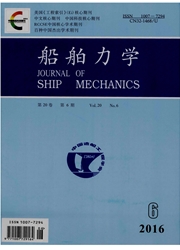

 中文摘要:
中文摘要:
SPS-SPH方法是为了克服经典SPH方法中人工粘性过于分散的缺点,以及克服改进的SPH方法中层流粘性不能准确捕捉湍流流体运动的不足。该方法借鉴大涡模拟方法的思想提出了一个亚粒子尺度(Sub-Particle Scale,简称SPS)涡粘性项并将它附加在Morris的层流粘性项之后。分别采用SPS-SPH方法和经典SPH方法对2D溃坝问题进行数值模拟并与实验数据进行了比较,结果表明,SPS-SPH方法的计算结果比经典SPH方法更加接近实验结果,该方法合理可靠,能够应用于数值模拟自由表面流动的相关问题。将SPS-SPH方法进一步运用于求解二维和三维典型自由表面流动问题,计算结果表明,SPS-SPH方法对于自由表面流动的数值模拟问题具有较高的精确度,对解决此类问题有较大的参考价值。
 英文摘要:
英文摘要:
The SPS-SPH method was proposed to overcome the shortcomings of too dispersive artifi-cial viscosity in Smoothed Particle Hydrodynamics (SPH) method, as well as to improve the disadvan-tage that the laminar viscous in improved SPH method can not capture the main features of turbulent flow accuracy. Using the concepts of Large Eddy Simulation (LES), the SPS-SPH method proposes the Sub-Particle Scale (SPS) eddy viscosity item which is added after the laminar viscosity item proposed by Morris et al. The SPS-SPH method was described in detail. A 2D dam-break model taken as the validation case was simulated by SPS-SPH method and SPH method, respectively. The numerical re-sults are compared with experimental data, which shows that SPS-SPH method is reasonable and re-liable in studying free surface flows. Furthermore, the SPS-SPH is applied to simulate two types of 2D and 3D free surface problems. The numerical results indicate that the SPS-SPH method has good accuracy in solving free surface flows and has a great reference value for solving such problems.
 同期刊论文项目
同期刊论文项目
 同项目期刊论文
同项目期刊论文
 期刊信息
期刊信息
